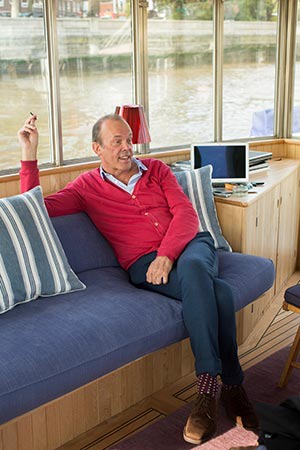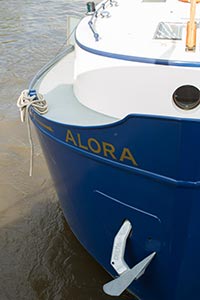From AC/DC to the Stones: lighting designer Patrick Woodroffe

Simply sign up to the Life & Arts myFT Digest -- delivered directly to your inbox.
Not all lighting designers can claim to be a bit rock ’n’ roll. Patrick Woodroffe does – and why not? In 1977 he toured the world as Rod Stewart’s lighting designer. Subsequently, he has lit shows for Abba, Cher, Tina Turner, Spandau Ballet, Simply Red, AC/DC, Bob Dylan, Take That, Michael Jackson, Lady Gaga, Elton John, Stevie Wonder and the Rolling Stones – to name a few.
Woodroffe, 60, lives mainly in Bath, in western England, but we meet on his boat on the Thames, near Albert Bridge – “the most beautifully lit bridge in London”. Based on a traditional Dutch barge design, Alora – the 72ft, six-year-old “pied-au-l’eau” – was built from scratch. Smartly painted white and blue, she is named after Woodroffe’s daughters, Alice and Laura.
“My brother, who’d been a roadie for small bands, turned me on to it,” he says. (The brother in question is Simon Woodroffe, founder of Yo! Sushi, the restaurant chain. With a houseboat nearby, Simon is also a neighbour.)
Woodroffe’s career took off in 1977 when Rod Stewart sacked his lighting designer three days before his A Night On The Town tour and Simon recommended Patrick. The show was “a triumph”, says Woodroffe merrily. “At the age of 22, I went round the world twice with Rod – in ’77 and ’79. It was just a wonderful life.” Before that, Woodroffe had studied at Marlborough College, where he received a “stilted English public school education” before being expelled.

Evening sun slants on to the deck, part of which was recycled from the British clipper Cutty Sark. Across the river, the trees of Battersea Park bend in the breeze. The boat creaks mellifluously and Woodroffe rolls a cigarette. The industry has transformed since he first set off with Stewart. In the early days, “the biggest rock bands were playing village halls” and technology was primitive. “You had a lighting board and music and you literally played the lighting board like an instrument,” he says. When bands started playing stadiums in the 1980s, production values developed, technology improved and the “business exploded”.

When he started, the road crew would be about 10 people. “Now when we go on tour with the Rolling Stones, it’s 230 people.” Woodroffe has been lighting the Rolling Stones since 1982, including the band’s 2006 gig on Copacabana Beach in Rio de Janeiro attended by more than 1.5m people.
As Woodroffe talks, smoke from his rollie curls into the air. He is tanned and the smoking seems at odds with his cherry red cardigan, jazzy socks and healthy complexion. Is he naturally artistic? “I think you have to be, to be a lighting designer,” he says. “At its simplest, you’re interpreting performance with light – which leaves a huge amount of scope.”
Woodroffe is at pains to point out that he has done more than just rock and pop concerts. “I’ve worked with a lot of classical musicians,” he says, reeling off a few names – Georg Solti, André Previn, the Three Tenors. He has also lit for Cirque du Soleil, opera, ballet, billionaires’ lakes and, for the past 16 years, Vanity Fair’s Oscar parties. And he did the lighting for the opening ceremony of London’s Olympic Games in 2012.

Below deck is tidy and minimal – grey carpet, purple upholstery and plenty of pale wood. The warm air is tinged with tobacco, as Woodroffe tries to explain his craft.
“It’s not trite to say that it is painting with light,” he says. “The stage is your canvas, the lights are your electronic paint box.” Different mediums present different challenges he adds: opera, for example, tends to be more disciplined than rock; when lighting circus, it’s best not to dazzle the tightrope walker.
Different stars also present different challenges. Woodroffe – oozing niceness – is not inclined to denounce his clients to a stranger but he offers characterful snippets. “Stones shows can be stressful”, Abba had a “lovely family vibe”, and Elton John gave him carte blanche in Las Vegas – “the best show we did in 40 years”. What about AC/DC? I ask. “AC/DC are great. The best. The funniest people I ever met in my life . . . I would say that all the people I’ve worked with, I have liked,” he adds.
Favourite things

In return for lighting a Mark Ronson tour, Woodroffe asked the musician/DJ to educate him musically.
“He came up on opening night, opened his bag and took out six beautiful leather cases with six iPods in them,” says Woodroofe. “On every iPod there were 250 tunes – one was disco, one was jazz, one was old classics, one was guitar music, and one was called ‘Soulful Sunday’ – and they were really delicately chosen.”
He may have liked them, but they haven’t all been easy. Building trust is part of the job. When Woodroffe meets his starry clients for the first time, he doesn’t talk about the lighting, he talks about “where they’re at in their careers – do they want to be this huge, glamorous rock star, do they want to be the guy in jeans just telling his story?”
Lighting takes time – “it’s never right when you start” – and rock stars are not always patient. They aren’t always disciplined either: “people don’t show up, people don’t rehearse”. Yet from the designer’s point of view, all the lighting “has to mean something – if it doesn’t, it’s just like being in a discotheque”.
In 2009, Woodroffe worked on Michael Jackson’s comeback tour This Is It, shortly before the singer died. “Michael Jackson just never used to show up for rehearsals,” says Woodroffe. “I used to say to him, if we just make this lighting without you being there, it doesn’t mean anything . . . but if you flick your fingers at the end of a number and there’s a blackout, they’ll believe you did that.”
In the days before Jackson’s death, “the old Michael” was back, apparently. “I think it would have been one of the great rock shows of all time.”

In 2012, Woodroffe lit Lady Gaga’s Born This Way tour. “She was wonderful. She was a handful. She was so sure of herself.”
The designer and Gaga disagreed stylistically and Gaga said (in Woodroffe’s words): “It feels like a wedding up here and I want it to feel like a nightclub.” Woodroffe was “lighting it too perfectly and too beautifully and too theatrically for her”. But the way Gaga wanted it lit “nobody would see her”. On his website, Woodroffe writes: “Gaga was very involved in the lighting of the show herself, to such a degree that I am happy to share the design credit with her!” To me, he adds: “She was really difficult.”
That same year, he lived on Alora for three months while rehearsing for the Olympics opening ceremony. “It’s like a very comfortable flat with mains electricity and water from the pier.” There is a small kitchen and his bedroom is in the bow, a curved oak room with portholes and a skylight.

How did he feel in the build-up to the most public gig of his life? Nervous, he admits. And it nearly went wrong. An hour before the show, only three of the Olympic rings would light up; the other two were soaked. “There were people up on the roof with hairdryers drying the connections.”
In his field, Woodroffe is virtually pre-eminent, but he is not famous. Does he crave fame? “I wouldn’t wish it on anyone . . . I see what fame and fortune does to people.”

The 60-year-old looks mellow on his boat. “I’m a very happy man. I’ve been very happily married for 30 years, which is a huge part of my success.” Not taking cocaine is also part of it. “Back in the ‘80s most people on the tour would take cocaine . . . It was just never my thing.”
Alora rocks with the tide. “Twice a year, we take her out,” he says. “To motor for six hours and pull up in a field outside Windsor . . . is a special thing.” He exhibits his boat like a favourite child – or horse. The first time Alora set sail on the Thames, “suddenly she was a thoroughbred – this was where she belonged”.
A life’s work complete, then? “In terms of music, probably yes.”
Not quite, however. After the interview, Woodroffe is off to rehearse with Elton John in Battersea Power Station – and it’s complicated because “a falcon suddenly gave birth in the middle of the site” and they’ve had to move the stage.
Photographs: Rick Pushinsky; Tom Jamieson
Comments